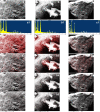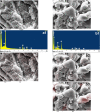Systemic analysis of urinary stones from the Northern, Eastern, Central, Southern and Southwest China by a multi-center study
- PMID: 30545321
- PMCID: PMC6293513
- DOI: 10.1186/s12894-018-0428-2
Systemic analysis of urinary stones from the Northern, Eastern, Central, Southern and Southwest China by a multi-center study
Abstract
Background: To provide some basis for the prevention of urinary stones in general population, we did a systemic analysis of urinary stones from Northern, Eastern, Central, Southern and Southwest China by a multi-center study.
Methods: A total of 11,157 urinary stones from Northern, Eastern, Central, Southern and Southwest China were obtained and analyzed by Fourier transform infrared spectroscopy. Combined with scanning electron microscopy and X-ray energy spectrometer, urinary stones were classified into different types. Furthermore, the correlation between stone types and clinical characteristics, as well as their regional distribution were elucidated.
Results: Calcium oxalate stones were the most common type in each region, followed by calcium oxalate-calcium phosphate mixed stones, uric acid stones and calcium phosphate stones. The distribution of calcium oxalate stones were highest prevalence in Southwest China (67.9%, P < 0.05), followed by Eastern and Northern China. Anhydrous uric acid stones, with a constituent ratio of 19.3% in Southern China, and 13.7% in Central China, were significantly higher than that in other regions (P < 0.05). Elements analysis indicated varieties among stone types as well as distribution regions. Moreover, the clinical characteristics were highly correlated with stone types and anatomical locations but not their distribution regions.
Conclusions: The material and elements composition of urinary stones among different regions showed some varieties. Calcium oxalate stone has the highest constituent ratio in Southwest China, while anhydrous uric acid stone has the highest constituent ratio in Southern China. Moreover, the clinical characteristics were highly correlated with stone types and anatomical locations but not their distribution regions.
Keywords: Calcium oxalate stones; Fourier transform infrared spectroscopy; Regional distribution; Scanning electron microscopy; Uric acid stones; Urinary stones; X-ray energy spectrometer.
Conflict of interest statement
Ethics approval and consent to participate
The sample collection procedures were explained to all patients. Written informed consent was obtained from all patients. The principles outlined in the Declaration of Helsinki of 1975 (revised in 1983 and 1989) were followed throughout the study period. The study was approved by both the Ethics Committee of The Sixth People’s Hospital of Nansha, Guangzhou (reference number is No: 20130821057P) and the Ethics Committee of The Kingmed Diagnostics Center of Guangzhou (KM20130149).
Consent for publication
Not applicable.
Competing interests
The authors have declared that no competing interests exist.
Publisher’s Note
Springer Nature remains neutral with regard to jurisdictional claims in published maps and institutional affiliations.
Figures




References
-
- Ramello A, Vitale C, Marangella M. Epidemiology of nephrolithiasis. J Nephrol. 2000;S(3):S45–S50. - PubMed
Publication types
MeSH terms
Substances
Grants and funding
LinkOut - more resources
Full Text Sources

